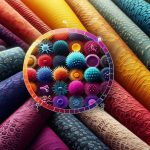Are you curious about whether silk fabric is antibacterial? Look no further. This article delves into the science behind the antibacterial properties of silk fabric, exploring how it acts as a natural defense against bacteria.
We’ll also discuss the mechanisms behind silk fabric’s antibacterial abilities and how it can effectively prevent bacterial growth. Discover the numerous benefits of antibacterial silk fabric and how it can help maintain hygiene and health.
Silk fabric is proving to be a promising antibacterial material.
Table of Contents
The Science Behind Antibacterial Properties of Silk Fabric
The science behind the antibacterial properties of silk fabric is still being researched. However, studies have shown that silk fabric has numerous benefits for skin health and wound healing. Silk contains a protein called sericin, which has been found to have antimicrobial properties. This means that it can help prevent the growth of bacteria on the skin, reducing the risk of infections.
Additionally, silk fabric has a smooth and soft texture, which can be gentle on the skin and help prevent irritation and inflammation.
Silk fabric is also known for its ability to regulate temperature and moisture. This can be especially beneficial for wound healing, as maintaining a moist environment is important for proper healing. Silk fabric can help keep wounds hydrated without causing excessive moisture buildup, allowing for optimal healing conditions.
Furthermore, silk fabric is hypoallergenic and less likely to cause allergic reactions compared to other fabrics, making it suitable for individuals with sensitive skin.
Silk Fabric: A Natural Defense Against Bacteria
Did you know that silk fabric has antibacterial properties? It’s true! Silk has been found to possess natural defense mechanisms against bacteria, making it a unique and valuable material.
But how does silk actually work to inhibit the growth of bacteria? In this discussion, we will explore the fascinating science behind silk’s antibacterial properties and delve into the mechanisms that make it such an effective defense against harmful microbes.
Silk’s Antibacterial Properties?
Silk’s antibacterial properties make it an ideal fabric for keeping bacteria at bay. Not only does silk have a luxurious feel and a lustrous appearance, but it also possesses unique characteristics that contribute to its antimicrobial nature.
Here are some key points to consider about silk’s antibacterial properties:
-
Moisture Wicking: Silk has the ability to absorb and wick away moisture from the body, keeping you dry and preventing the growth of bacteria that thrive in damp environments.
-
Hypoallergenic: Silk is naturally hypoallergenic, meaning it is less likely to cause allergic reactions or irritate sensitive skin. This is beneficial for individuals with allergies or skin conditions.
-
Sericin: Silk contains a protein called sericin, which has been found to have antimicrobial properties. Sericin acts as a protective barrier on the silk threads, inhibiting the growth of bacteria.
-
Silk Fibroin: The fibroin protein found in silk has also been shown to have antimicrobial effects. It can help prevent the growth of bacteria, fungi, and other microorganisms on the fabric.
How Does Silk Work?
Silk works by utilizing its unique properties, such as moisture wicking and sericin protein, to create a fabric that is both luxurious and antimicrobial. Silk production involves carefully cultivating silkworms and harvesting their cocoons, which are then spun into silk threads. These threads are then woven together to create the smooth, shiny fabric we know as silk.
Silk’s moisture wicking properties allow it to absorb and release moisture, keeping you dry and comfortable. Additionally, silk contains a protein called sericin, which naturally repels bacteria and prevents odors. This makes silk clothing an excellent choice for those with sensitive skin or allergies, as it is hypoallergenic and less likely to cause irritation.
To give you a better understanding of silk’s benefits, here is a table showcasing some of its key features:
| Feature | Description |
|---|---|
| Moisture wicking | Absorbs and releases moisture, keeping you dry |
| Antimicrobial properties | Naturally repels bacteria and prevents odors |
| Luxurious feel | Smooth and shiny fabric with a luxurious touch |
Understanding the Mechanisms of Silk Fabric’s Antibacterial Abilities
Did you know that silk fabric possesses antibacterial properties?
Understanding the mechanisms behind silk’s antibacterial effects is crucial in comprehending its antimicrobial action.
Silk’s Antibacterial Properties
You’ll be pleased to know that silk fabric has antibacterial properties. Silk’s antimicrobial activity is due to its unique chemical structure and surface properties.
Here are some key points to understand silk’s antibacterial properties:
- Silk contains natural proteins called sericin and fibroin, which have been found to exhibit antibacterial activity against various types of bacteria.
- The hydrophobic nature of silk fabric prevents the attachment of bacteria, inhibiting their growth and proliferation.
- Silk’s smooth surface reduces the chances of bacterial adhesion, making it difficult for bacteria to colonize on the fabric.
- Silk fabric has been shown to have a high resistance to bacterial growth, making it an ideal material for applications where bacterial resistance is important.
- Studies have demonstrated that silk fabrics can inhibit the growth of pathogenic bacteria, including Staphylococcus aureus and Escherichia coli.
Mechanisms of Silk’s Antibacterial Effects
The unique chemical structure and surface properties of silk contribute to its ability to inhibit the growth of bacteria. Silk contains natural antimicrobial peptides that possess antibacterial properties. These peptides have the ability to disrupt the integrity of bacterial cell membranes, leading to cell death. Additionally, silk’s surface properties play a role in its antibacterial effectiveness. The smooth surface of silk prevents bacteria from adhering to it, reducing the likelihood of bacterial colonization and growth. Moreover, silk’s moisture-wicking properties help to create an unfavorable environment for bacterial growth by keeping the fabric dry and inhibiting the accumulation of moisture that bacteria thrive on. The combination of these mechanisms makes silk fabric highly effective in inhibiting the growth of bacteria.
| Mechanisms | Effectiveness |
|---|---|
| Antimicrobial peptides | Disrupt bacterial cell membranes |
| Smooth surface | Prevent bacterial adherence |
| Moisture-wicking properties | Inhibit bacterial growth by keeping fabric dry |
Understanding Silk’s Antimicrobial Action
Now that you understand how silk fabric’s antibacterial effects work, let’s delve deeper into its impact on skin health and role in wound healing.
Silk fabric’s impact on skin health:
- Silk fabric is known for its hypoallergenic properties, making it gentle and non-irritating to the skin.
- The smooth surface of silk helps reduce friction against the skin, preventing skin irritation and pressure sores.
- Silk’s natural moisture-wicking properties help keep the skin hydrated and prevent dryness, which is essential for maintaining healthy skin.
Silk’s role in wound healing:
- The antimicrobial properties of silk fabric can help prevent infection in wounds.
- Silk has been found to accelerate wound healing by promoting the growth of new blood vessels and encouraging the production of collagen.
- The smooth and breathable nature of silk fabric allows wounds to breathe, preventing moisture buildup and aiding in the healing process.
Silk Fabric: An Effective Solution for Preventing Bacterial Growth
Did you know that silk fabric is an effective solution for preventing bacterial growth? Not only is silk known for its luxurious feel and sheen, but it also possesses remarkable antimicrobial properties. This makes it an ideal choice for individuals with sensitive skin or those who seek sustainable options.
Silk fabric has been used for centuries due to its natural resistance to bacterial growth. The protein structure of silk contains amino acids that have been found to inhibit the growth of bacteria. This means that silk fabric can act as a barrier against harmful microbes, reducing the risk of skin infections.
Additionally, silk is hypoallergenic and gentle on the skin, making it an excellent choice for individuals with sensitive skin conditions such as eczema or psoriasis. It is breathable and moisture-wicking, allowing for better regulation of body temperature and reducing the likelihood of sweat-induced bacterial growth.
Furthermore, silk is a sustainable option compared to synthetic fabrics. It is a renewable resource that requires less water and energy to produce, making it an environmentally friendly choice. Silk fabric is also biodegradable, meaning it will naturally break down over time and have a minimal impact on the environment.
Exploring the Benefits of Antibacterial Silk Fabric
Not only does silk possess remarkable antimicrobial properties, but it also offers a multitude of benefits for individuals with sensitive skin or those seeking sustainable options. Silk fabric innovation has brought about various applications that make it an excellent choice for those looking for antibacterial textiles.
Here are some key benefits of antibacterial silk fabric:
-
Natural antimicrobial properties: Silk contains a protein called sericin, which has been found to exhibit antimicrobial activity against a wide range of bacteria. This makes silk fabric an effective solution for preventing bacterial growth and reducing the risk of infections.
-
Hypoallergenic: Silk is known for its hypoallergenic properties, making it suitable for individuals with sensitive skin. It is less likely to cause skin irritations or allergic reactions compared to other synthetic fabrics.
-
Moisture-wicking: Silk fabric is highly absorbent and can effectively wick away moisture from the skin, keeping you dry and comfortable throughout the day.
-
Temperature regulation: Silk has excellent thermal properties, helping to regulate body temperature in both cold and hot climates. It can keep you warm in the winter and cool in the summer.
-
Sustainable and eco-friendly: Silk is a natural fiber that is biodegradable and renewable. It is produced from the cocoons of silkworms, making it a sustainable choice for those seeking environmentally-friendly options.
With its remarkable antimicrobial properties and numerous benefits, silk fabric has proven to be a versatile and innovative material for a wide range of applications. Whether you’re looking for antibacterial textiles for medical purposes or simply want to experience the comfort and luxury of silk, this natural fabric is a great choice.
How Silk Fabric Can Help Maintain Hygiene and Health
With its hypoallergenic and moisture-wicking properties, silk fabric contributes to maintaining hygiene and promoting good health.
When it comes to skin health, silk fabric offers several benefits. Firstly, its smooth and soft texture helps prevent skin irritation and friction, making it an ideal choice for those with sensitive skin or skin conditions like eczema.
Silk fabric also has natural temperature-regulating properties, which can help prevent excessive sweating and keep your skin cool and comfortable throughout the night. Moreover, silk is known for its ability to retain moisture, which can help keep your skin hydrated and prevent dryness. This is particularly beneficial for individuals with dry or aging skin.
Additionally, silk fabric is naturally resistant to dust mites, mold, and mildew, making it a great option for those with allergies or asthma. Its antibacterial properties further contribute to maintaining hygiene by inhibiting the growth of bacteria on the fabric.
The Role of Silk Fabric in Fighting Harmful Bacteria
To fight harmful bacteria effectively, you should consider incorporating silk fabric into your daily routine. Silk fabric has been found to have antibacterial properties, making it a valuable tool in promoting hygiene and preventing infections.
One area where silk fabric has shown promising results is in wound healing. Studies have found that silk dressings can help reduce the risk of infection and promote faster healing. The natural proteins present in silk, such as sericin and fibroin, have antimicrobial properties that can inhibit the growth of harmful bacteria. This is especially beneficial for individuals with compromised immune systems or chronic wounds.
Furthermore, silk fabric can also play a role in preventing respiratory infections. The smooth and breathable nature of silk allows for better airflow and ventilation, reducing the risk of bacteria buildup and the transmission of respiratory pathogens. This can be particularly advantageous in crowded or polluted environments where the risk of infections is higher.
Incorporating silk fabric into your daily routine can be as simple as using silk pillowcases, sheets, or clothing. The following table highlights some common silk fabric products and their potential benefits in fighting harmful bacteria:
| Silk Fabric Product | Potential Benefits |
|---|---|
| Silk dressings | Promotes wound healing and reduces infection risk |
| Silk pillowcases | Prevents bacteria buildup and reduces risk of respiratory infections |
| Silk clothing | Promotes ventilation and reduces risk of skin infections |
Silk Fabric: A Promising Antibacterial Material
Silk fabric has been found to have properties that can inhibit the growth of harmful bacteria, making it a promising material for fighting infections. The antibacterial properties of silk are primarily attributed to a protein called sericin, which is found in the outer layer of the silk cocoon. Studies have shown that sericin can effectively prevent the growth of various bacteria, including Staphylococcus aureus and Escherichia coli.
The potential applications of silk fabric in combating bacterial infections are vast. One promising application is the development of antibacterial clothing and textiles. Silk garments could help reduce the risk of infection by preventing the growth and spread of harmful bacteria on the fabric’s surface. This could be particularly beneficial in healthcare settings, where the transmission of infections is a significant concern.
Furthermore, silk fabric could also be utilized in the production of medical devices, such as wound dressings and surgical implants. By incorporating antibacterial silk into these products, it may be possible to reduce the risk of postoperative infections and improve patient outcomes.
While the antibacterial properties of silk fabric have been extensively studied, there is still room for future research. Further investigation is needed to understand the mechanisms by which silk inhibits bacterial growth and develop more efficient methods for incorporating antibacterial properties into silk textiles. Additionally, studies exploring the long-term durability and effectiveness of antibacterial silk fabric in real-world applications are warranted.
Such research could pave the way for the widespread use of silk fabric in various medical and healthcare settings, ultimately helping to combat infections and improve patient safety.
Conclusion
In conclusion, silk fabric has been proven to possess antibacterial properties, making it an effective solution for preventing bacterial growth.
The mechanisms behind silk fabric’s antibacterial abilities are still being studied, but it is believed that the fabric traps and kills bacteria upon contact.
By incorporating silk fabric into our daily lives, we can maintain hygiene and health, as it helps fight harmful bacteria.
With its promising potential as an antibacterial material, silk fabric is a valuable asset in our quest for a cleaner and healthier environment.
- Where to Buy Tetron Fabric: Top Retailers and Online Stores - June 17, 2025
- Tetron Fabric Suit: Style and Comfort Combined - June 17, 2025
- Tetron Fabric for Bags: Durability and Design Tips - June 17, 2025




